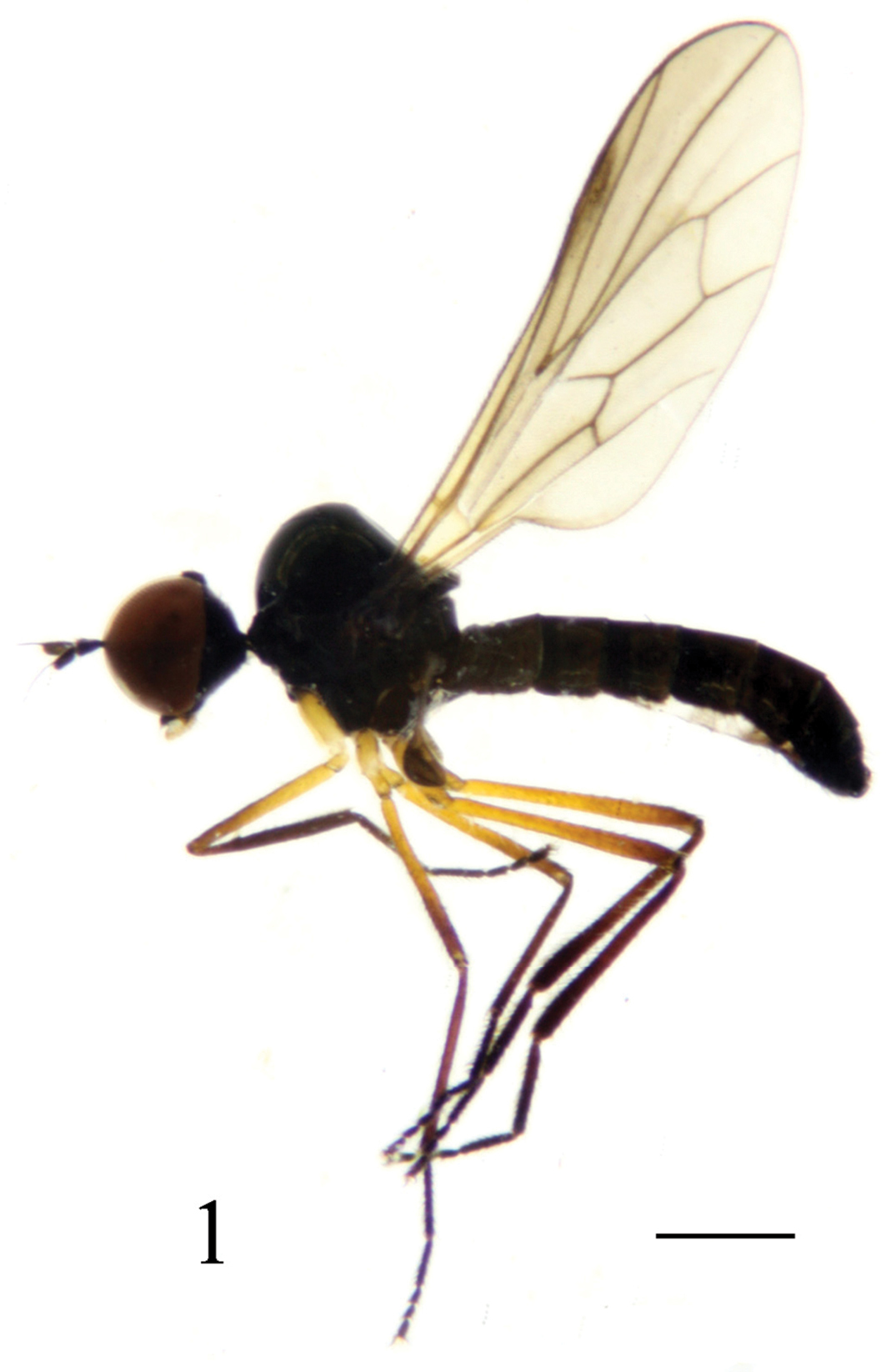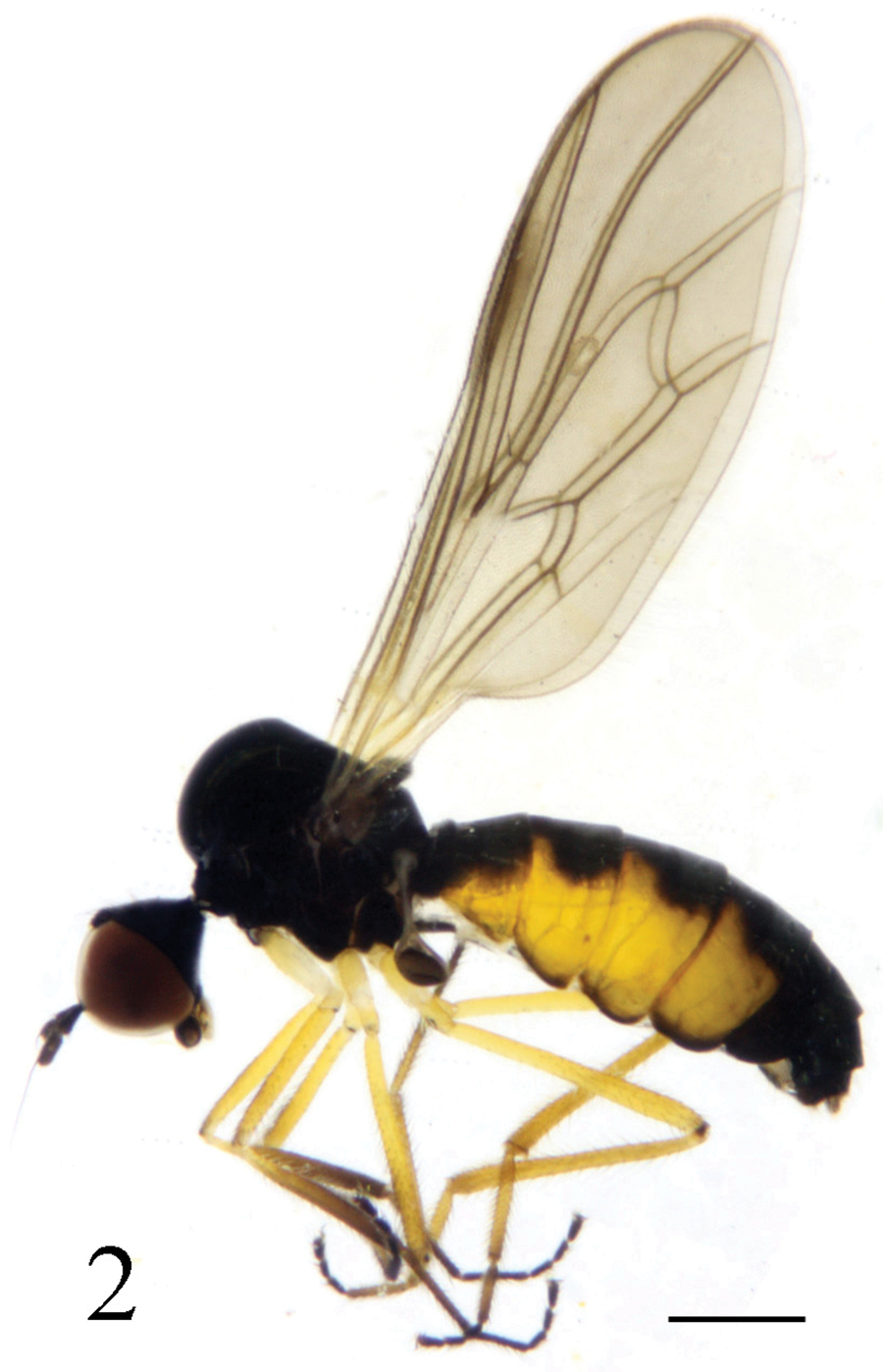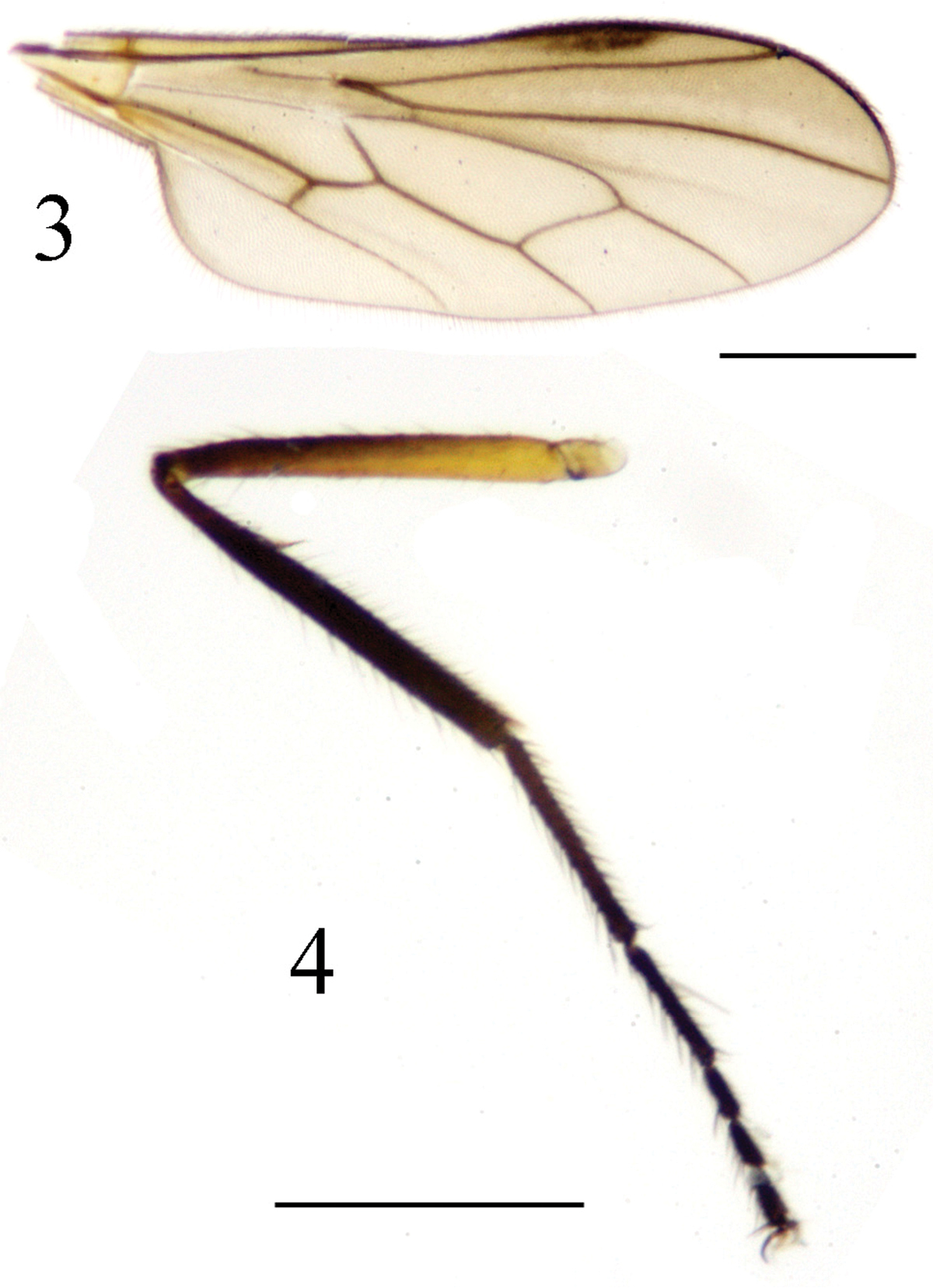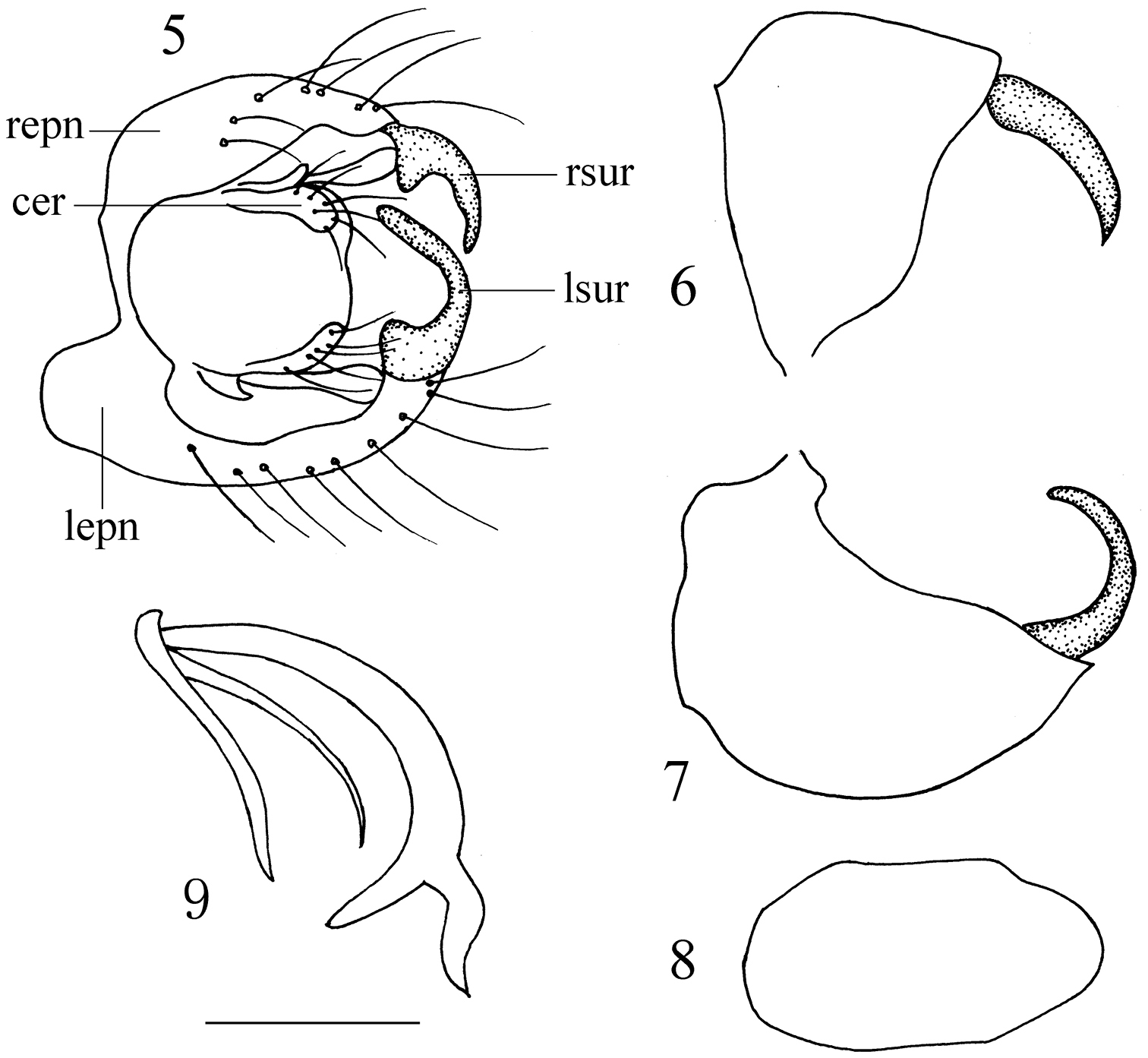






(C) 2013 Yan Li. This is an open access article distributed under the terms of the Creative Commons Attribution License 3.0 (CC-BY), which permits unrestricted use, distribution, and reproduction in any medium, provided the original author and source are credited.
For reference, use of the paginated PDF or printed version of this article is recommended.
Citation: Li Y, Wang M, Yang D (2013) A new species of Ocydromia Meigen from China, with a key to species from the Palaearctic and Oriental Regions (Diptera, Empidoidea, Ocydromiinae). ZooKeys 349: 1–9. doi: 10.3897/zookeys.349.5473
Previously only one species of the genus Ocydromia Meigen was recorded from China. Here a second species of the genus from China, Ocydromia shanxiensis sp. n., is reported. A key to the species of the genus from the Palaearctic and Oriental regions is presented.
Diptera, Empidoidea, Ocydromia, new species, China
The genus Ocydromia Meigen, 1820 is characterized by the following features: first flagellomere elliptical; arista long, supra-apical, bare and one-segmented; proboscis very short and fleshy; mesonotum almost bare, acr uni- or biserial; wing broad, 2 veins from broad discal cell; legs lacking distinct setae (
The biology of Ocydromia species is very interesting. Ocydromia glabricula (Fallén) displays obligate multilarviparity (
Previously only one species, Ocydromia xiaowutaiensis Yang & Gaimari, was recorded from China (
The types of the new species are deposited in the Entomological Museum of China Agricultural University (CAU), Beijing. Basic terminology follows
(modified from
| 1 | Stigma long and narrow; mesonotum with no more than one spot | 2 |
| – | Stigma short and round; mesonotum with a median vitta and black spot above each wing base [male unknown] (Burma) | Ocydromia stigmatica Frey |
| 2 | Thorax mostly or entirely black in male, black or more or less yellow in female | 3 |
| – | Thorax bright brownish yellow with an oval black spot on anterior part of mesonotum [female unknown] (India) | Ocydromia unifasciata (Brunetti) |
| 3 | Thorax including pleuron black in both sexes; sense-organ of fore tibia with narrow hair brush pointed apically | 4 |
| – | Thorax mostly black or brownish yellow in male but more or less yellow in female; sense-organ of fore tibia with wide hair brush obtuse apically | 5 |
| 4 | Scutellum with one pair of distinct marginal setae (additional lateral marginal setae hardly differentiated from setulae along fringe); right surstylus strongly curved inwards, hypandrium truncated apically (Europe) | Ocydromia melanopleura Loew |
| – | Scutellum with three pairs of distinct marginal setae (apical pair longest); right surstylus weakly curved inwards, hypandrium not truncated apically (Palaearctic China) | Ocydromia shanxiensis sp. n. |
| 5 | Setulae on sense-organ of fore tibia soft and curved inwards apically; left and right epandrial lamellae fused basally by short narrow band, right surstylus without acute inner denticles apically, hypandrium wide basally but slightly narrowed towards tip [female unknown] (Palaearctic China) | Ocydromia xiaowutaiensis Yang et Gaimari |
| – | Setulae on sense-organ of fore tibia straight; left and right epandrial lamellae fused basally by long narrow band, right surstylus with two acute inner denticles apically, hypandrium narrow basally and wide apically | Ocydromia glabricula (Fallén) |
http://zoobank.org/1D91ED0D-EF45-493A-B8E3-220A3133D5DE
http://species-id.net/wiki/Ocydromia_shanxiensis
Figs 1–9Thorax polished black in both sexes; female abdomen partly yellow. Scutellum with three pairs of marginal setae. Legs mostly blackish, except coxae and trochanters yellow, and femora brownish yellow except apical portions of fore and mid femora brown and apical portion of hind femur brownish. Sense-organ of fore tibia with narrow hair brush pointed apically. Hypandrium distinctly longer than wide, with obtuse apex.
Male (Fig. 1). Body length 3.1–3.2 mm, wing length 2.8–2.9 mm.
Ocydromia shanxiensis sp. n., male adult. Scale bar 1 mm.
Head black with gray pollinosity. Eyes contiguous on frons, brownish, with upper facets slightly enlarged; face linear. Setulae and setae on head black, posteroventral setulae dark yellow. Ocellar tubercle distinct with 2 long oc and 2 very short posterior setulae. Antenna black; pedicel with circlet of black subapical setulae; first flagellomere elliptical, 2.0 times longer than wide, minutely pubescent; arista long (2.7–2.8 times as long as first flagellomere), supra-apical, bare, one-segmented and black. Proboscis short, mostly brownish yellow, with black setulae; palpus black with black setulae and 2 thin black setae.
Thorax mostly polished black except postalar callus dark brownish yellow; mesonotum with narrow mid-lateral area and scutellum with gray pollinosity. Setulae on thorax blackish, setae weak and black; setulae on mesonotum sparse; humerus with 3–4 setulae, without h; 2 npl; acr and dc uniseriate and hair-like; 1 sa; 1 psa; 1 prsc; scutellum with short dense pubescence and 3 pairs of sc (apical pair distinctly longer than lateral pairs). Legs mostly blackish, except coxae and trochanters yellow, and femora brownish yellow except apical portions of fore and mid femora brown and apical portion of hind femur brownish. Setulae and setae on legs blackish, setae weak; coxae with yellow setulae and setae, hind femur with hair-like av slightly longer than femur thickness. Sense-organ of fore tibia with narrow hair brush pointed apically (Fig. 4). Hind tibia distinctly thickened apically; hind tarsomere 1 slightly thickened, slightly shorter than tarsomeres 2–5. Wing (Fig. 3) hyaline, tinged gray; stigma dark brown, about 1/4 as long as cell r1; veins dark brown. Squama dark brown with dark brown setulae. Halter dark brown.
Abdomen slightly curved downward and polished blackish; venter with gray pollinosity. Setulae and setae on abdomen blackish; tergites 1–2 with dark yellow lateral setulae, sternites 1–2 with dark yellow setulae.
Male genitalia (Figs 5–9). Left and right epandrial lamellae fused basally by narrow band. Left epandrial lamella narrow in dorsal view; left surstylus finger-like, strongly curved inwards. Right epandrial lamella wide basally in dorsal view; right surstylus weakly curved inwards with acute apex; left and right cerci subequal in length and obtuse apically. Hypandrium distinctly longer than wide, with obtuse apex. Two branches of bifid appendage at tip of phallus equally long but unequally stout.
Female (Fig. 2). Body length 3.1–3.4 mm, wing length 3.6–3.7 mm. Similar to male, but abdomen distinctly swollen, tergites 2–5 yellow laterally and tergite 6 sometime yellow at antero-lateral portion. Legs dark yellow except coxae and trochanters yellow, fore tibia and tarsus blackish; mid and hind tibiae dark brownish yellow, tarsi dark brown except tarsomere 1 dark yellow and tarsomere 2 brownish.
Ocydromia shanxiensis sp. n., female adult. Scale bar 1 mm.
Ocydromia shanxiensis sp. n. (male) 3 wing 4 fore tibia, lateral view. Scale bar 1 mm.
Ocydromia shanxiensis sp. n. 5 male genitalia, dorsal view 6 right epandrial lamella and surstylus, lateral view 7 left epandrial lamella and surstylus, lateral view 8 hypandrium, ventral view 9 phallus, lateral view. Abbreviations: cer = cercus; lepn = left epandrial lamella; lsur = left surstylus; repn = right epandrial lamella; rsur = right surstylus. Scale bar = 0.1 mm.
Holotype: male, China: Shanxi Province, Yicheng, Yishan, Dahe, 2012.VII.24, Zhenghua Zhang (in 75% alcohol, deposited in CAU). Paratypes: 3 males, 4 females, same data as holotype (in 75% alcohol, deposited in CAU); 1 male, 1 female, China: Shanxi Province, Yicheng, Yishan, Dahe, 2012.VII.23, Chen Wang (in 75% alcohol, deposited in CAU).
China (Shanxi).
The new species is similar to the European species Ocydromia melanopleura, but may be distinguished from the latter by the scutellum with three pairs of distinct marginal setae (apical pair longest), right surstylus weakly curved inwards, and hypandrium obtuse apically. In Ocydromia melanopleura, the scutellum has only one pair of distinct marginal setae, the right surstylus is strongly curved inwards, and the hypandrium is truncated apically (
The species is named after the type locality Shanxi.
We are very grateful to Mr. Zhenghua Zhang and Mr. Chen Wang (Beijing) for collecting specimens, and to Mr. Wenliang Li and Mr. Xiao Zhang (Beijing) for their help during the study. Two anonymous reviewers are thanked for providing useful comments on an earlier draft of this paper. The research was funded by the National Natural Science Foundation of China (31272354, 31111140015), the Fundamental Research Funds for the Central Universities (2013QJ082), National “Twelfth Five-Year” Plan for Science & Technology Support (2012BAD19B00), and the Ministry of Science and Technology of the People’s Republic of China (2012FY111100, MOST Grant 2011FY120200).



